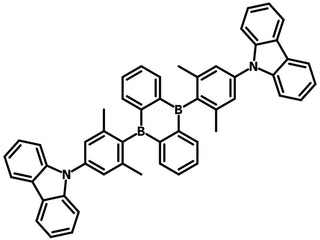CzDBA
CAS Number 2171334-43-1
Dopant Materials, Green Dopant Materials, High Purity Sublimed Materials, Materials,Green Dopant Material with Boron-based Carbazoles
High purity sublimed thermally activated delayed fluorescent (TADF) emitter for highly efficient OLEDs, 5,10-Bis(4-(9H-carbazol-9-yl)-2,6-dimethylphenyl)-5,10-dihydroboranthrene, CAS No. 2171334-43-1, Sublimed ≥99.0%
CzDBA is a diboron compound with a D-A-D structure of two electron-donating carbazoles on both ends and an electron-accepting dihydroboranthrene in the middle, bridged by two 2,6-dimethylphenyls between the donor and acceptor units.
High purity sublimed material
>99.5%
Worldwide shipping
Quick and reliable shipping
Enhances OLED stability
Balanced electron and hole transport with a broad recombination zone
Excellent PLQY
~100% and an 84% horizontal dipole ratio in the thin film
CzDBA from Ossila was used in the high-impact paper (IF 14.7), Inverted device architecture for high efficiency single-layer organic light-emitting diodes with imbalanced charge transport, X. Tan et al., Nat. Commun., 15, 4107 (2024). DOI: 10.1038/s41467-024-48553-1.
With near-trap-free and remarkably balanced bipolar electron and hole transport characteristics, CzDBA is a thermally activated delayed fluorescence (TADF) emitter, converting triplet excitons into singlet excitons via reverse intersystem crossing (RIC). This D-A-D type structure generates TADF with a photoluminescence quantum yield of ~100% and an 84% horizontal dipole ratio in the thin film. A green OLED based on CzDBA exhibits a high external quantum efficiency of 37.8 ± 0.6%, a current efficiency of 139.6 ± 2.8 cd A−1 and a power efficiency of 121.6 ± 3.1 lm W−1 with an efficiency roll-off of only 0.3% at 1,000 cd m−2. Furthermore, the balanced electron and hole transport results in a broad recombination zone, leading to greatly enhanced device stability.
General Information
| CAS number | 2171334-43-1 |
|---|---|
| Chemical formula | C52H50B2N2 |
| Molecular weight | 714.51 g/mol |
| Absorption* | λmax 342 nm (in toluene) |
| Fluorescence | λem 524 nm (in film) |
| HOMO/LUMO | HOMO = 5.93 eV, LUMO = 3.45 eV |
| Synonyms | 5,10-Bis(4-(9H-carbazol-9-yl)-2,6-dimethylphenyl)-5,10-dihydroboranthrene |
| Classification / Family | Carbazole derivatives, Green dopant, TADF materials, Sublimed materials. |
Chemical Structure

Product Details
| Purity | Sublimed* >99% (HPLC) |
|---|---|
| Melting point | TGA: n.a. |
| Appearance | White crystals/powder |
* Sublimation is a technique used to obtain ultra pure-grade chemicals, see sublimed materials for OLED devices.
MSDS Documentation
Literature and Reviews
-
Diboron compound-based organic light-emitting diodes with high efficiency and reduced efficiency roll-off, T. Wu et al., Nature Photon 12, 235–240 (2018); DOI: 10.1038/s41566-018-0112-9
-
Substituent engineering of the diboron molecular architecture for a nondoped and ultrathin emitting layer, T. Wu et al., Chem. Sci., 13, 12996 (2022); DOI: 10.1039/d2sc04725j.
-
Molecular Origin of Balanced Bipolar Transport in Neat Layers of the Emitter CzDBA, W. Liu et al., Adv. Mater. Technol., 6 (2), 2000120 (2021); DOI: 10.1002/admt.202000120.
